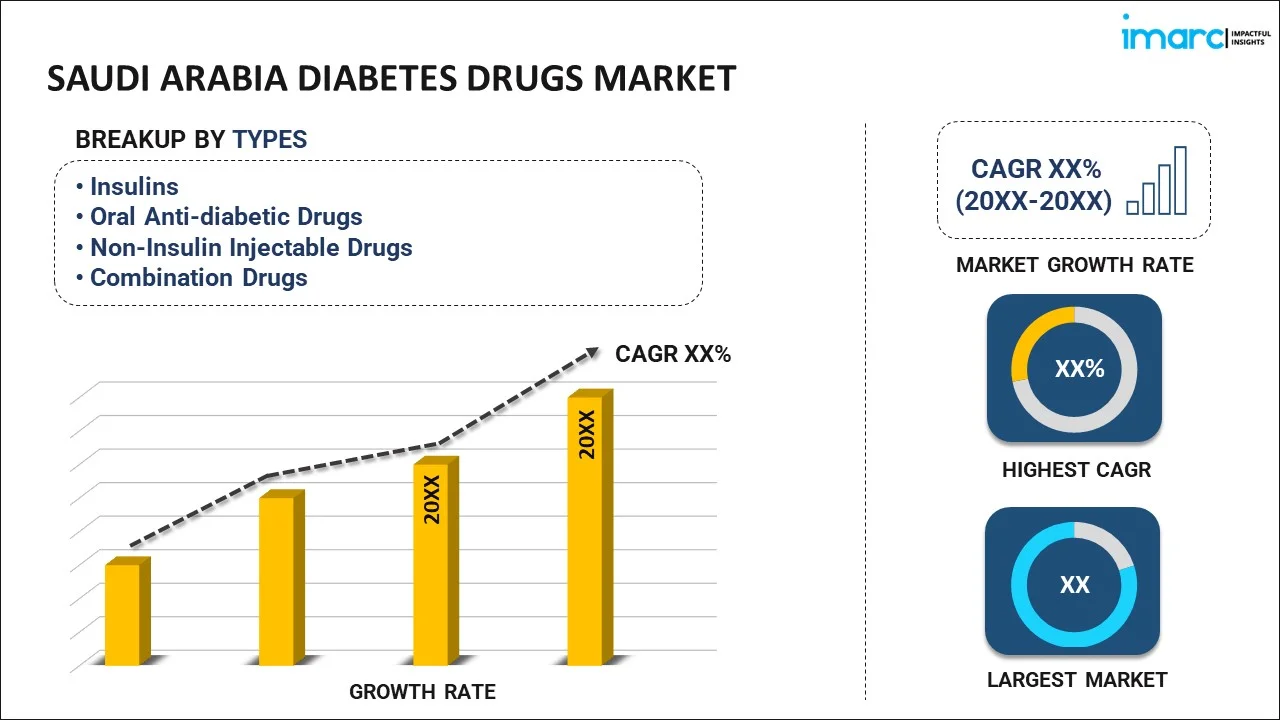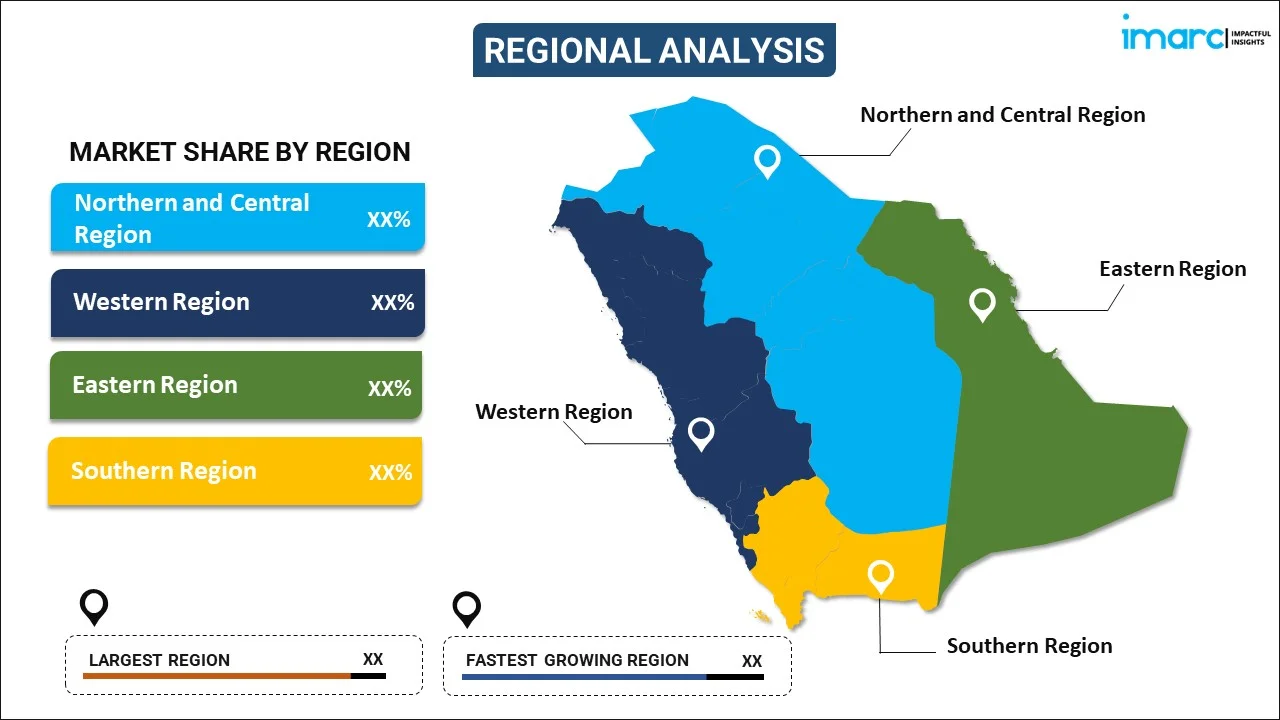
Saudi Arabia Diabetes Drugs Market Report by Type (Insulins, Oral Anti-diabetic Drugs, Non-Insulin Injectable Drugs, Combination Drugs), Distribution Channel (Online Pharmacies, Hospital Pharmacies, Retail Pharmacies), and Region 2025-2033
Market Overview:
Saudi Arabia diabetes drugs market size reached USD 829.6 Million in 2024. Looking forward, IMARC Group expects the market to reach USD 1,687.4 Million by 2033, exhibiting a growth rate (CAGR) of 8.21% during 2025-2033. The rising prevalence of diabetes, the widespread adoption of innovative medications, and government healthcare initiatives are primarily driving the market growth.
|
Report Attribute
|
Key Statistics
|
|---|---|
|
Base Year
|
2024
|
|
Forecast Years
|
2025-2033
|
|
Historical Years
|
2019-2024
|
| Market Size in 2024 | USD 829.6 Million |
| Market Forecast in 2033 | USD 1,687.4 Million |
| Market Growth Rate 2025-2033 | 8.21% |
Diabetes drugs are a class of medications specifically formulated to manage and treat diabetes, a chronic condition where the body either doesn't produce adequate insulin or cannot effectively use the insulin it produces. They work in various ways, depending on the type of diabetes and its severity. For Type 1 diabetes, insulin injections or pumps are typically required, as the body doesn't produce any insulin. For Type 2 diabetes, there are diverse medications available that help increase insulin sensitivity, reduce glucose production, or stimulate the pancreas to release more insulin. Some commonly used oral agents include metformin, sulfonylureas, and DPP-4 inhibitors. Additionally, newer classes of drugs, like SGLT2 inhibitors, act on the kidneys to excrete sugar from the body through urine. The goal of these medications is to maintain blood glucose levels within a target range, reducing the risk of complications associated with prolonged high blood sugar, such as neuropathy, retinopathy, and cardiovascular issues. It's essential to pair these drugs with a balanced diet, regular monitoring, and physical activity for optimal management of diabetes.
Saudi Arabia Diabetes Drugs Market Trends:
The Saudi Arabia diabetes drugs market is witnessing significant growth, influenced by a confluence of factors, including the country's rising diabetes prevalence, evolving healthcare infrastructure, and innovative pharmaceutical advancements. Diabetes is a growing health concern in the Kingdom, attributed to factors like sedentary lifestyles and dietary habits, contributing to a higher demand for diabetes management and treatment options. Moreover, these medications offer improved glycemic control and have demonstrated benefits in cardiovascular risk reduction, making them increasingly popular choices for managing diabetes. Additionally, the use of insulin analogs, which offer better glycemic control and reduced risk of hypoglycemia, is on the rise. The government's focus on enhancing healthcare services and accessibility plays a pivotal role in the market's growth. Initiatives like the Saudi Vision 2030 prioritize healthcare infrastructure development, encouraging investments in pharmaceutical manufacturing, research, and development, fostering a favorable environment for diabetes drug innovation. Furthermore, increasing diabetes awareness and proactive healthcare measures are driving early diagnosis and treatment, further boosting the demand for diabetes drugs. Telemedicine and digital health platforms have also gained traction, offering remote monitoring and consultation services to patients, which is expected to propel the regional market over the forecasted period.
Saudi Arabia Diabetes Drugs Market Segmentation:
IMARC Group provides an analysis of the key trends in each segment of the market, along with forecasts at the country level for 2025-2033. Our report has categorized the market based on type and distribution channel.
Type Insights:

- Insulins
- Basal or Long Acting Insulins
- Bolus or Fast Acting Insulins
- Traditional Human Insulins
- Biosimilar Insulins
- Oral Anti-diabetic Drugs
- Biguanides
- Alpha-Glucosidase Inhibitors
- Dopamine D2 Receptor Agonist
- SGLT-2 Inhibitors
- DPP-4 Inhibitors
- Sulfonylureas
- Meglitinides
- Non-Insulin Injectable Drugs
- GLP-1 Receptor Agonists
- Amylin Analogue
- Combination Drugs
- Insulin Combinations
- Oral Combinations
The report has provided a detailed breakup and analysis of the market based on the type. This includes insulins (basal or long acting insulins, bolus or fast acting insulins, traditional human insulins, and biosimilar insulins), oral anti-diabetic drugs (biguanides, alpha-glucosidase inhibitors, dopamine D2 receptor agonist, SGLT-2 inhibitors, DPP-4 inhibitors, sulfonylureas, and meglitinides), non-insulin injectable drugs (GLP-1 receptor agonists and amylin analogue), and combination drugs (insulin combinations and oral combinations).
Distribution Channel Insights:
- Online Pharmacies
- Hospital Pharmacies
- Retail Pharmacies
A detailed breakup and analysis of the market based on the distribution channel have also been provided in the report. This includes online pharmacies, hospital pharmacies, and retail pharmacies.
Regional Insights:

- Northern and Central Region
- Western Region
- Eastern Region
- Southern Region
The report has also provided a comprehensive analysis of all the major regional markets, which include Northern and Central Region, Western Region, Eastern Region, and Southern Region.
Competitive Landscape:
The market research report has also provided a comprehensive analysis of the competitive landscape in the market. Competitive analysis such as market structure, key player positioning, top winning strategies, competitive dashboard, and company evaluation quadrant has been covered in the report. Also, detailed profiles of all major companies have been provided.
Saudi Arabia Diabetes Drugs Market Report Coverage:
| Report Features | Details |
|---|---|
| Base Year of the Analysis | 2024 |
| Historical Period | 2019-2024 |
| Forecast Period | 2025-2033 |
| Units | Million USD |
| Scope of the Report | Exploration of Historical and Forecast Trends, Industry Catalysts and Challenges, Segment-Wise Historical and Predictive Market Assessment:
|
| Types Covered |
|
| Distribution Channels Covered | Online Pharmacies, Hospital Pharmacies, Retail Pharmacies |
| Regions Covered | Northern and Central Region, Western Region, Eastern Region, Southern Region |
| Customization Scope | 10% Free Customization |
| Post-Sale Analyst Support | 10-12 Weeks |
| Delivery Format | PDF and Excel through Email (We can also provide the editable version of the report in PPT/Word format on special request) |
Key Questions Answered in This Report:
- How has the Saudi Arabia diabetes drugs market performed so far and how will it perform in the coming years?
- What has been the impact of COVID-19 on the Saudi Arabia diabetes drugs market?
- What is the breakup of the Saudi Arabia diabetes drugs market on the basis of type?
- What is the breakup of the Saudi Arabia diabetes drugs market on the basis of distribution channel?
- What are the various stages in the value chain of the Saudi Arabia diabetes drugs market?
- What are the key driving factors and challenges in the Saudi Arabia diabetes drugs?
- What is the structure of the Saudi Arabia diabetes drugs market and who are the key players?
- What is the degree of competition in the Saudi Arabia diabetes drugs market?
Key Benefits for Stakeholders:
- IMARC’s industry report offers a comprehensive quantitative analysis of various market segments, historical and current market trends, market forecasts, and dynamics of the Saudi Arabia diabetes drugs market from 2019-2033.
- The research report provides the latest information on the market drivers, challenges, and opportunities in the Saudi Arabia diabetes drugs market.
- Porter's five forces analysis assist stakeholders in assessing the impact of new entrants, competitive rivalry, supplier power, buyer power, and the threat of substitution. It helps stakeholders to analyze the level of competition within the Saudi Arabia diabetes drugs industry and its attractiveness.
- Competitive landscape allows stakeholders to understand their competitive environment and provides an insight into the current positions of key players in the market.
Need more help?
- Speak to our experienced analysts for insights on the current market scenarios.
- Include additional segments and countries to customize the report as per your requirement.
- Gain an unparalleled competitive advantage in your domain by understanding how to utilize the report and positively impacting your operations and revenue.
- For further assistance, please connect with our analysts.
 Request Customization
Request Customization
 Speak to an Analyst
Speak to an Analyst
 Request Brochure
Request Brochure
 Inquire Before Buying
Inquire Before Buying




.webp)




.webp)












